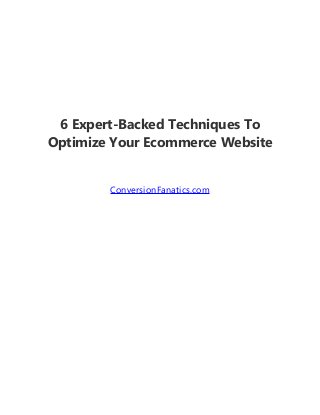
6 Expert-backed techniques to optimize your ecommerce website
- 1. 6 Expert-Backed Techniques To Optimize Your Ecommerce Website ConversionFanatics.com
- 2. When it comes to ecommerce optimization, your work is really never complete and the process can be arduous. Here are six top strategies, with lots of expert advice, to help optimize your website so you can increase your conversion rates.
- 3. 1. Curtail Duplicate Content Ironically, this bears repeating: Curtail duplicate content because it will hurt your search engine rank. Stacey Politi of Yahoo discusses how to reduce the negative effects of duplicate content below. Stacey Politi, Digitial Marketer: "To minimize this: • Canonicalize your links. • Submit your URL to Google. • Syndicate your content…wisely. • Reference your URL consistently. • When your content is being reused without your permission, request that Google remove the page under the Digital Millennium Copyright Act."
- 4. 2. Don't Be A Digital Wallflower Many brands have Facebook fan pages and Twitter accounts (if you don't, you should get on that asap), but other social networks exist that are also relevant and can deliver a lot of targeted traffic to your site—networks such as Pinterest, Instagram, LinkedIn, and Google+. Image Source You should also create a variety of content that lends itself to being shared on a variety of platforms—content that includes images, infographics, and videos.
- 5. 3. Add Open Graph Tags Speaking of Facebook, open graph tags allow you to have more control over how content from your website is shared on Facebook. And according to Jacek Blaut of Growth Republic, open graph tags "can affect conversions and click-through rates hugely." Jack Blaut: "For example, have you ever shared a link on Facebook only to find that the thumbnail was missing, or there was a totally different picture than you expected? Knowing just a little about Open Graph tags can help you tackle these problems. Adding Open Graph tags to your website won’t directly affect your on-page SEO, but it will influence the performance of your links on social media, so that means it’s worth looking into." To learn more about how to use and optimize open graph tags, check out the rest of Jack's post on Kissmetrics or this cheat sheet provided by Cyrus Shepard.
- 6. 4. Include User-Generated Content Unless you're afraid of what people might say about your products or services, user- generated content offers significant SEO benefits to your website, such as better conversion rates, more sales, and higher rankings with search engines, thanks to the content's uniqueness. Some examples of user-generated content include customer testimonials, reviews, and social proof from Facebook likes and shares, tweets, pins, and Google+ 1s. You can also use Schema.org's review markup to "get stars beside your listing in the SERPs from individual product pages, and this affects click-through rates," says Trond Lyngbø of Search Planet. Image Source
- 7. 5. Integrate A Q&A Content System Another type of unique, user-generated content you can add to your site is a question and answer system that's directed at your products and services. Paddy Moogan of Aira: "There are a few benefits to integrating this type of system: • Scalable, user-generated content published onto product pages • Improving ranking[s] for long-tail terms and question- driven keywords if the content is crawlable • Possible improvement in conversion rate[s] if customer concerns are addressed in the answers • Possibility of encouraging brand evangelists and even bringing in some gamification principles to help motivate users." Image Source
- 8. 6. Minimize Shopping Cart Abandonment Cart abandonment is a big problem for ecommerce sites—whether it occurs because the process is too complex, customers run out of time or don't feel like creating an account or they discover that their preferred payment method isn't accepted. Plus, even a mere two-second delay in a page's loading time can significantly increase a website's cart abandonment rate. Sharon Hurley Hall: "There’s lots of advice on streamlining the shopping cart experience for better conversions, including: • Showing people how far they are in the process so they know something is happening. • Reducing the number of pages needed to complete a transaction. • Ensuring that shoppers know up front whether a product is available or not. • Keeping the checkout page simple so that there are no distractions. • Remembering the cart so that shoppers who come back later can resume shopping immediately."
- 9. What do you think about these ecommerce optimization strategies? What other techniques can you share?
- 10. What do you think about these ecommerce optimization strategies? What other techniques can you share?
